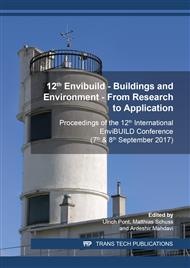p.181
p.189
p.196
p.204
p.212
p.219
p.227
p.237
p.247
Analyzing the Relation between Input Data and Key Performance Indicators for Building Energy Certificates: An Approach Using Algorithmic Modeling
Abstract:
This contribution concerns the reproducibility of energy certificates. To examine the impact of different input data assumptions on the results of energy certificates, sensitivity analysis was performed. Conducting such sensitivity analysis manually is not only time consuming and error-prone, but is also typically limited in view of input-data/result combinations. This can be a problem, as a number of input data combinations can have contradictory influences on corresponding KPI (key performance indicator) results. For instance, transparent building components increase not only solar gains, but also transmittance losses. As an alternative to manual modification of input data, the parametric algorithm-editor, Grasshopper (an Add-on to the CAD/CAM-environment Rhino) was utilized. The calculation standards of the Austrian energy certificate procedure were implemented in this environment. Input data values can be modified via a graphical user interface (rulers), and the impact of the change is instantly generated by the environment. Past research regarding planners' usage of energy certificate tools identified usability and overall user acceptance of such calculation tools as a weak spot. Thus, the implementation of calculation routines within a widely used drafting/parametrization tool could result in increased acceptance by planners. In a first methodological approach, the impact of input assumptions regarding building typology and window properties on solar gains, transmittance losses, and heating demand were considered. The contribution illustrates the method and the results of a number of case studies, which show that the concept can be usefully deployed in energy evaluation of buildings. Thereby, the approach can accommodate two requirements: On the one hand, it can result in a tool to evaluate building concepts in early design stages. On the other hand, it can serve as a conceptual vehicle to explore and evaluate calculation methods, such as the standardized energy certification procedure.
Info:
Periodical:
Pages:
212-218
Citation:
Online since:
January 2019
Price:
Сopyright:
© 2019 Trans Tech Publications Ltd. All Rights Reserved
Share:
Citation:


